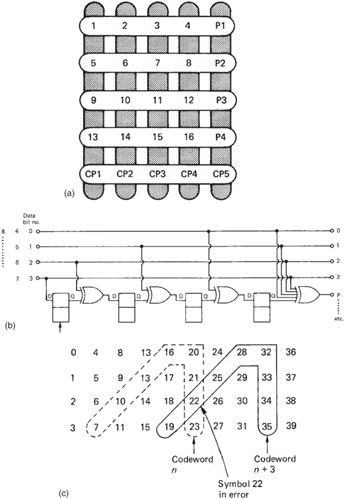3.14 Block and Convolutional Codes
| | ||
| | ||
| | ||
3.14 Block and Convolutional Codes
Figure 3.21(a) shows a strategy known as a crossword code, or product code. The data are formed into a two-dimensional array, in which each location can be a single-bit or a multi-bit symbol. Parity is then generated on both rows and columns . If a single bit or symbol fails, one row parity check and one column parity check will fail, and the failure can be located at the intersection of the two failing checks. Although two symbols in error confuse this simple scheme, using more complex coding in a two-dimensional structure is very powerful, and further examples will be given throughout this chapter.

Figure 3.21: A block code is shown in (a). Each location in the block can be a bit or a word. Horizontal parity checks are made by adding P1, P2, etc., and cross-parity or vertical checks are made by adding CP1, CP2, etc. Any symbol in error will be at the intersection of the two failing codewords. In (b) a convolutional coder is shown. Symbols entering are subject to different delays which result in the codewords in (c) being calculated. These have a vertical part and a diagonal part. A symbol in error will be at the intersection of the diagonal part of one code and the vertical part of another.
The example of Figure 3.21(a) assembles the data to be coded into a block of finite size and then each codeword is calculated by taking a different set of symbols. This should be contrasted with the operation of the circuit of (b). Here the data are not in a block, but form an endless stream. A shift register allows four symbols to be available simultaneously to the encoder. The action of the encoder depends upon the delays. When symbol 3 emerges from the first delay, it will be added (modulo-2) to symbol 6. When this sum emerges from the second delay, it will be added to symbol 9 and so on. The codeword produced is shown in (c) to be bent such that it has a vertical section and a diagonal section. Four symbols later the next codeword will be created one column further over in the data.
This is a convolutional code because the coder always takes parity on the same pattern of symbols convolved with the data stream on an endless basis. Figure 3.21(c) also shows that if an error occurs, it can be located because it will cause parity errors in two codewords. The error will be on the diagonal part of one codeword and on the vertical part of the other so that it can be located uniquely at the intersection and corrected by parity.
Comparison with the block code of Figure 3.21(a) will show that the convolutional code needs less redundancy for the same single-symbol location and correction performance as only a single redundant symbol is required for every four data symbols. Convolutional codes are computed on an endless basis which makes them inconvenient in networks where packet multiplexing is anticipated. Here the block code is more appropriate as it allows switching gaps to be created between codes.
Convolutional codes work best in channels suffering from Gaussian noise and will be found in broadcasting. They can easily be taken beyond their correcting power if used with a bursty channel.
| | ||
| | ||
| | ||
EAN: 2147483647
Pages: 120